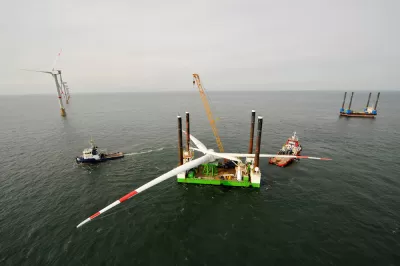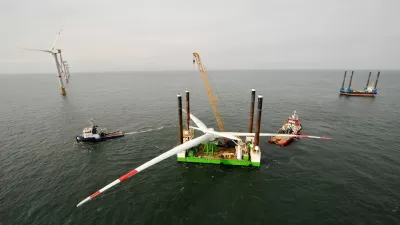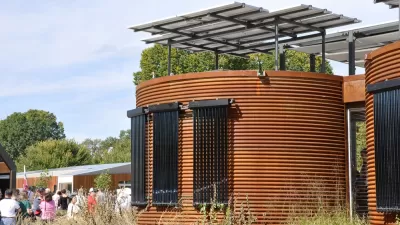In a few years, Maryland is expected to be the nation's leader in offshore renewable wind power made possible by the Public Service Commission's approval on May 11 of credits to two projects by U.S. Wind and Skipjack Offshore Energy.

May 11 was a significant day for renewable power in the United States. The Maryland Public Service Commission (PSC) awarded offshore wind renewable energy credits (also called certificates in New Jersey) to two projects to be built between 12 and 21 nautical miles off the coast, enabling construction of what is expected to be the nation's second and possibly third, and by far largest, construction of offshore wind farms, a common form of renewable power in Europe but struggling in the U.S.
The commission's "decision enables U.S. Wind, Inc. and Skipjack Offshore Energy, LLC to construct 368 megawatts of capacity, together yielding over $1.8 billion of in-state spending, spurring the creation of almost 9,700 new direct and indirect jobs and contributing $74 million in state tax revenues over 20 years," according to the commission's press release [pdf].
- U.S. Wind, Inc. a subsidiary of Renexia S.p.A., a leader in renewable energy in Italy, was approved by the commission to construct 62 turbines, 12-15 nautical miles offshore, generating 248 MW. Operational date estimated to be 2020
- Skipjack was authorized to build 15 turbines, 17-21 nautical miles offshore, generating 120 MW. Operational date: 2022.
Skipjack is a subsidiary of Deepwater Wind, LLC, which built and operates Block Island Wind Farm, America's first offshore wind farm located off Block Island, Rhode Island. The 30 megawatt, 5 turbine farm began operation last December.
Last January, Deepwater also received approval to build the South Fork Wind Farm off Montauk, Long Island, consisting of 15 advanced offshore wind turbines able to generate 90 megawatts of power. Approval had been delayed last July.
Aesthetics
Visibility of turbines was one factor that helped topple the Cape Wind project (currently suspended) off Cape Cod, Massachusetts. With Ocean City being one of the Old Line State's most popular resort destinations, visibility of the turbines was factored into the approval conditions by the commission.
“We certainly recognize that there is strong public demand to make sure that sightlines to the turbines—particularly from Ocean City—are minimized to the fullest extent possible,” said Commissioner Anthony O’Donnell.
“As a condition of our order, US Wind is required to locate its project as far to the east (away from the shoreline) of the designated wind energy area as practical. Each developer also must take advantage of the best commercially-available technology to lessen views of the wind turbines by beach-goers and residents, both during the day and at night.”
Environmental targets
The offshore wind farms figure prominently into meeting two of Maryland's climate goals:
- Reducing carbon emissions 40 percent by 2030 per the 2016 reauthorization of the Greenhouse Gas Emissions Reduction Act. [Similar to SB 32 in California]
- Maryland’s Renewable Energy Portfolio Standard (RPS) has a mandate of 25 percent of electricity purchased from renewable energy resources by 2020, and
The Maryland Climate Coalition was a major backer of both projects. "The people have shown up and spoken out in support of offshore wind...," stated David Smedick, Maryland Beyond Coal Campaign and Policy Representative for the Sierra Club, in the coalition's press release. "We have been working to get offshore wind to Maryland for over five years so this decision from the PSC is truly one of our biggest moments."
The coalition traces the success to the Maryland Offshore Energy Act of 2013 signed by former Gov. Martin O'Malley.
Scott Dance, who writes about the environment and the weather at The Baltimore Sun, reports that the Maryland wind turbines will "add $1 to monthly residential electricity bills once the windmills start spinning."
Hat tip to David O'Leary, Conservation Committee, Maryland Chapter.
FULL STORY: Maryland Positions Itself as Nation's Leader in Offshore Wind Power

Planetizen Federal Action Tracker
A weekly monitor of how Trump’s orders and actions are impacting planners and planning in America.

San Francisco's School District Spent $105M To Build Affordable Housing for Teachers — And That's Just the Beginning
SFUSD joins a growing list of school districts using their land holdings to address housing affordability challenges faced by their own employees.

The Tiny, Adorable $7,000 Car Turning Japan Onto EVs
The single seat Mibot charges from a regular plug as quickly as an iPad, and is about half the price of an average EV.

With Protected Lanes, 460% More People Commute by Bike
For those needing more ammo, more data proving what we already knew is here.

In More Metros Than You’d Think, Suburbs are Now More Expensive Than the City
If you're moving to the burbs to save on square footage, data shows you should think again.

The States Losing Rural Delivery Rooms at an Alarming Pace
In some states, as few as 9% of rural hospitals still deliver babies. As a result, rising pre-term births, no adequate pre-term care and "harrowing" close calls are a growing reality.
Urban Design for Planners 1: Software Tools
This six-course series explores essential urban design concepts using open source software and equips planners with the tools they need to participate fully in the urban design process.
Planning for Universal Design
Learn the tools for implementing Universal Design in planning regulations.
Smith Gee Studio
City of Charlotte
City of Camden Redevelopment Agency
City of Astoria
Transportation Research & Education Center (TREC) at Portland State University
US High Speed Rail Association
City of Camden Redevelopment Agency
Municipality of Princeton (NJ)




























